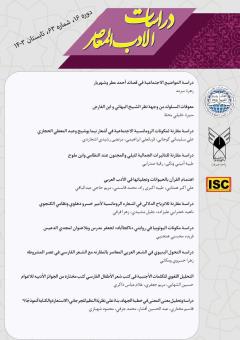دراسة وتحليل معنى المعنى في خطبة الجهاد، بناءً على نظريّة النظم للجرجاني (الاستعارة والكناية أنموذجًا)
محورهای موضوعی : Contemporary Literature Studies
قاسم مختاری
1
*
![]() ,
عبدالحسین افشار
2
,
محمد جرفي
3
,
عبدالحسین افشار
2
,
محمد جرفي
3
![]() ,
محمود شهبازی
4
,
محمود شهبازی
4
1 - جامعة اراک
2 - سرچهان شهر کره ای
3 - عضو هيأة التدريسيين بجامعة اراك
4 - دانشگاه اراک
کلید واژه: نهج البلاغة, الاستعارة, نظريّة النظم, الكناية, معنى المعنى,
چکیده مقاله :
دراسة وتحليل معنى المعنى في خطبة الجهاد، بناءً على نظريّة النظم للجرجاني (الاستعارة والكناية أنموذجًا) يُعدّ معنى المعنى واحدًا من أكثر المصطلحات دقّةً ورقّةً والتي طرحها الجرجاني بتأسيسه لنظريّة النظم، فغيّر بها النصوص من مجرّد بنية ثابتة وساكنة، إلى عمليّة حيّة ونشطة. يسعى البحث الماثل لدراسة معنى المعنى في خطبة الجهاد، بناءً على نظريّة النظم للجرجاني، وقد أخضعنا الاستعارة والكناية للنقاش باعتبارهما محورين رئيسين في تلك النظريّة. إنّ اكتشاف ما ينويه الإمامعليه السلام ويقصده في الجمل ذات الطبقات المتعدّدة، اعتمادًا على نظريّة النظم للجرجاني ومعنى المعنى، لهو من جملة الأهداف التي نصبو إليها في هذا العمل البحثي. ومن خلال هذه العمليّة، جرى تقييم ودراسة المستوى النحوي والدلالي والعناصر الباعثة على التماسك في الجمل التي لها صلة مباشرة بمعنى المعنى. تشير نتائج هذه المقالة، التي أُعدّت بالمنهج التحليلي-الوصفي، إلى أنّ أمير المؤمنين قد استفاد من الاستعارة والكناية حسب ما تقتضيه الأجواء السائدة. وفي بعض الحالات، وبسبب وضوح الحقائق الموجودة وجلائها، وكذلك من أجل تسخير عقول الجمهور، احتفظ مولانا الإمام عليعليه السلام بالوظيفة التوثيقيّة (إعطاء المعلومات) للجمل، وفي الحالات التي أراد فيها تحريض الجمهور أو إغراءهم أو إنذارهم أو ذمّهم، قام بتبيين غايته ومراده ضمن الاستعارة والكناية، ونقَل غرضه وقصده إلى الجمهور في بنية ضمنيّة جميلة ومؤثّرة.
Analyzing the meaning of the meaning in the Jihad sermon, based on Jurjani's theory of order (a case study of metaphor and irony) The meaning of meaning is one of the most delicate and delicate terms that Jurjani put forward by establishing her theory of order and changed the text from a static and static structure to a living and dynamic process. The Current research aims to investigate the meaning of meaning in the Jihad sermon, based on Jurjani's theory of order that Metaphor and irony have been explored as its two main axes. One of the goals of this research is to understand the main meaning of Imam (a.s.) in the sentences that have multiple layers. In this process, the syntactic level and elements of coherence of the sentences, which are directly related to the meaning, have been evaluated. The results of this article, which were carried out in an analytical-descriptive method, indicate that Amir Momenan (A.S.) used metaphor and irony based on the requirements of the ruler. In some cases, due to the clarity and obviousness of the existing facts, as well as capturing the audience's mind, the sentences retain the referential function (information). And in cases where they intended to provoke, persuade or warn the audience, they expressed their purpose and meaning in the form of metaphor and irony and They have conveyed their purpose to the audience in a beautiful and effective implied structure

